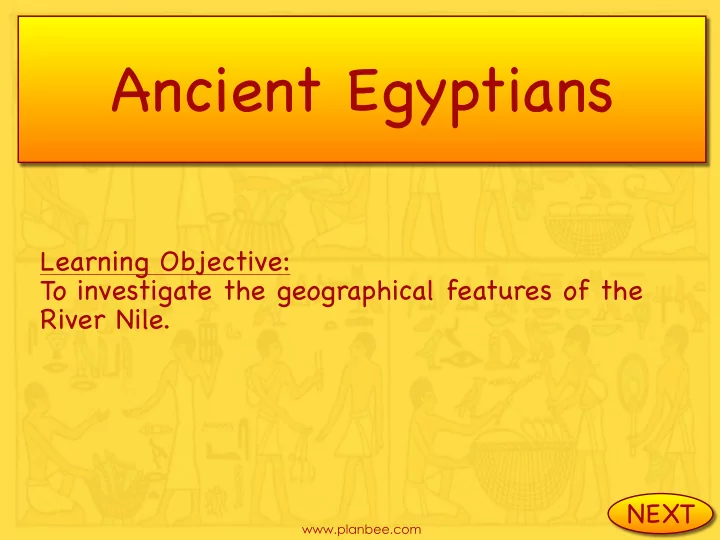

Ancient Egyptians Learning Objective: To investigate the geographical features of the River Nile. NEXT www.planbee.com
What do you already know about the River Nile? Think, pair, share your ideas. BACK NEXT www.planbee.com
What ideas did you come up with? What we know about the River Nile: BACK NEXT www.planbee.com
The River Nile runs through Africa and is the longest river in the world at around 6695 km (4184 miles) in length. It has two main tributaries, the White Nile and the Blue Nile, which meet to form one river in Khartoum, Sudan. It then flows north to Egypt and into the Mediterranean Sea. The point where the river runs into the sea is called the mouth of the river. The Nile runs through nine countries altogether: Uganda, Sudan, Ethiopia, Kenya, Dominican Republic of Congo, Tanzania, Rwanda, Burundi and, of course, Egypt. BACK NEXT www.planbee.com
mouth tributary tributary BACK NEXT www.planbee.com
What is a tributary? A tributary is a river or stream that flows into the main or ‘parent’ river. The White Nile and the Blue Nile are the tributaries of the Nile. The White Nile is longer than the Blue Nile but it only contributes around 15% of the water in the Nile because lots of the water is lost along the way. The Blue Nile contributes around 85% of the flow of the Nile. The Nile at Did you know...? Khartoum where Around 300 million the White Nile and cubic metres of water Blue Nile are discharged from meet the Nile every day. BACK NEXT www.planbee.com
Where does the Nile begin? The point a river begins is known as the source. Sources of rivers are usually in areas of high altitude like mountains or hills. The water then runs down these high areas until they reach the sea. Some people say the source of the Nile is Lake Victoria which is the biggest lake in Africa. However, there are lots of feeder rivers to Lake Victoria. The real source of the Nile is widely regarded as being the Kagera River in Burundi, although there is still some argument about where the Nile truly begins. The Kagera River, central Africa BACK NEXT www.planbee.com
Up until 1970, the River Nile used to flood every year. It covered the land with a rich, black mud that made the land very fertile. This was great for growing crops but sometimes the water level was too high and it washed the crops away. Other times, there were droughts so no crops could grow. Today, the River Nile no longer floods because of the Aswan Dam. This allows the flow of water to be controlled so that water can be stored for times of drought and held back so that the water doesn’ t flood the land. The Aswan Dam BACK NEXT www.planbee.com
How well were you listening?! See if you can answer these questions about the Nile... BACK NEXT www.planbee.com
What sea does the mouth of the Nile flow into? How many countries altogether does the Nile run through? What are the names of the two tributaries? What is the name for the point where a river begins? BACK NEXT www.planbee.com
What sea does the mouth of the Nile flow into? How many countries The Mediterranean Sea altogether does the Nile run through? Nine countries What are the names of the two tributaries? The White Nile and the What is the name for the Blue Nile point where a river begins? The source BACK NEXT www.planbee.com
What do you think the River Nile is used for? Discuss your ideas. BACK NEXT www.planbee.com
The ancient Egyptians depended on the River Nile for their way of life. Which of these uses still apply today? Is it still used for Is it still used for Ancient Egyptian Use this toda is today? Farming: the River Nile provided water and rich mud YES NO so that crops could grow Washing: people would use the water to wash YES NO themselves in and do their laundry in the river Fishing: fishermen would go out on papyrus boats to YES NO catch fish to eat Funerals: people often transported mummies to their YES NO tombs on the other side of the river by boat Trading: the River Nile allowed people to travel easily YES NO to different places for trade BACK NEXT www.planbee.com
Recommend
More recommend